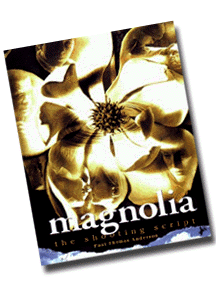Paul Thomas Anderson
The year of 1999 produced a number of amazing motion pictures. The recent Writers' Guild of America nominations are a striking reminder of the talent that went into some of those films. One screenplay noted by the WGA (and certainly headed for an Academy Award nomination) is Paul Thomas Anderson's Magnolia. This companion book is a fascinating document of the writer-director at work, and a fine memento of a striking film.
In the book's introduction, Anderson outlines his intentions for writing the screenplay. While he has been often criticized for being self-indulgent, Anderson's words prove both a damning conviction and a stark accquittal. Anderson credits himself with writing a "truly great movie," but he gives credit where it's heavily due to the actors, musicians, lovers and collaborators who inspire and assist him. If I had to define the qualities which make for a great filmmaker, the dichotomy of ego and praise would have to top the list, for better or worse.
Credit is also due Anderson for displaying his work in this format. While some artists would insist the finished work (in this case, the released version of the film) is the only experience, this book allows the reader to experience the film's blueprint. The shooting script - apparently photocopied, not re-typeset - is included in its entirety, including scenes that didn't make it to the finished film (with one scene apparently duplicated by accident as #285A and #293). There are some unique aspects of the printed version, however. Whereas the film contained some specific thematic images (the numbers 8 and 2, weather notes, etc.) the screenplay is often incomplete in these aspects - one notation reads simply:
Title card: Weather information,etc.
Despite these lapses,
the screenplay resembles the finished product to an amazing degree. Anderson
appears to have clearly imagined the his film while committing the words
to the page. One can vividly imagine the overlapping visuals and dialogue
of the opening title sequence from the description in the screenplay -
and it's almost exactly how the sequence was put together on screen.
The book's back cover likens the "lyrical script" to a "work of great fiction. While this is somewhat of an exaggeration, the script is quite literary in feel. Anderson's language is sometimes raw and offensive, but the writing is direct and evocative. Perhaps because Anderson directed this screenplay himself, typical script conventions seem to have been thrown out the window. Typos and strange structures are left intact. Emphasis is uniquely created by capitalizing every word in important sentences, such as "This Was Not Just A Matter Of Chance." Speeches sometimes last half a page (and once, almost the whole page). The script is a monster, at 194 pages (rule of thumb - one page equals one minute on screen), but a reader should find it an easy and vivid read, with the minor distractions of technical notes placed by "filmmaker" Paul Thomas Anderson rather than "screenwriter" Paul Thomas Anderson.
Following the main body of the book, there are a few extra features. A full cast and crew list is provided, along with a beautiful section of color and black and white photos taken on the set. Most interesting, however, is a brief, yet enlightening, interview with Paul Thomas Anderson where he discusses his motivations and his feelings about the characters in the story.
While this book is probably most appealing to fans of the film, it can still be considered a good read for film fans in general. The extra features provided are not extensive, but they provide some insight into the creative process of a unique filmmaker.
- Derek Miner
 |
|
 |
